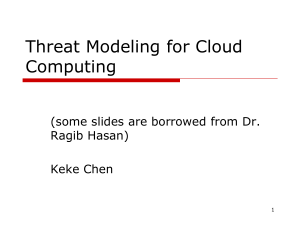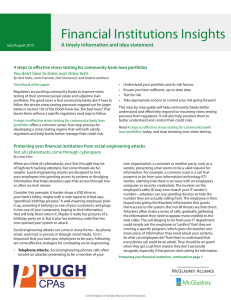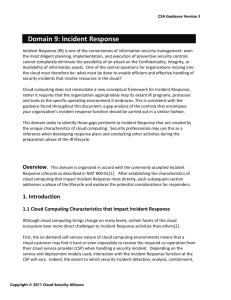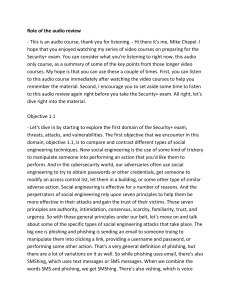The Future of Security - Cloud Security Alliance
advertisement
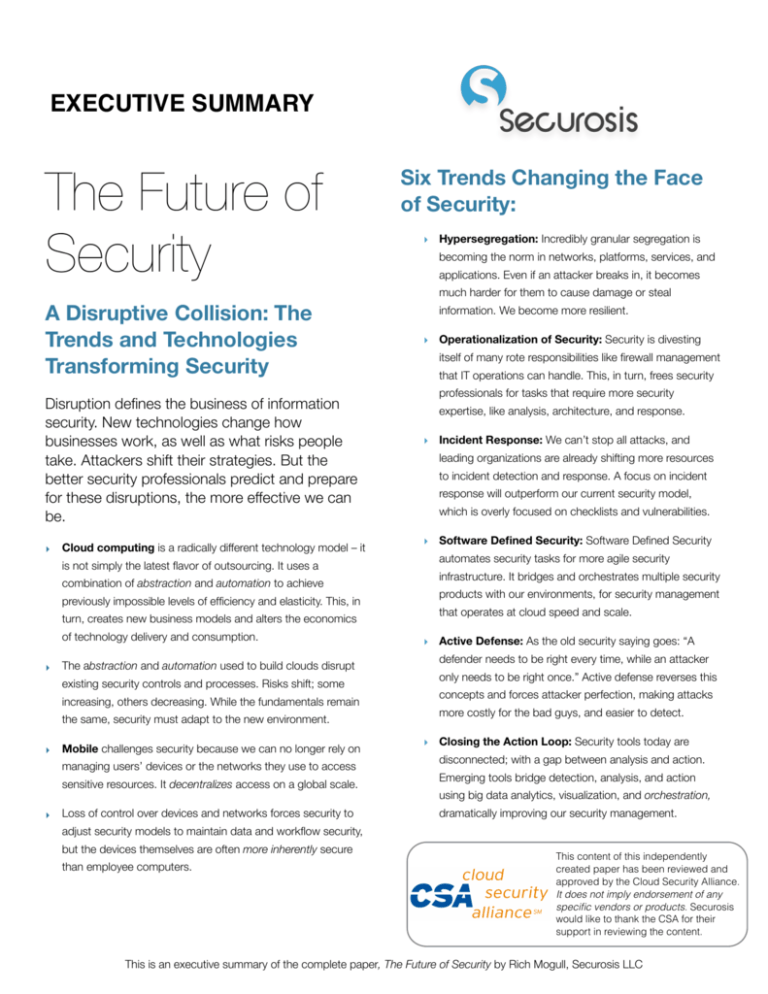
! EXECUTIVE SUMMARY ! The Future of Security Six Trends Changing the Face of Security: ‣ Hypersegregation: Incredibly granular segregation is becoming the norm in networks, platforms, services, and applications. Even if an attacker breaks in, it becomes much harder for them to cause damage or steal A Disruptive Collision: The Trends and Technologies Transforming Security Disruption defines the business of information security. New technologies change how businesses work, as well as what risks people take. Attackers shift their strategies. But the better security professionals predict and prepare for these disruptions, the more effective we can be. ‣ Cloud computing is a radically different technology model – it is not simply the latest flavor of outsourcing. It uses a combination of abstraction and automation to achieve previously impossible levels of efficiency and elasticity. This, in turn, creates new business models and alters the economics of technology delivery and consumption. ‣ The abstraction and automation used to build clouds disrupt existing security controls and processes. Risks shift; some increasing, others decreasing. While the fundamentals remain the same, security must adapt to the new environment. ‣ Mobile challenges security because we can no longer rely on managing users’ devices or the networks they use to access sensitive resources. It decentralizes access on a global scale. ‣ Loss of control over devices and networks forces security to information. We become more resilient. ‣ Operationalization of Security: Security is divesting itself of many rote responsibilities like firewall management that IT operations can handle. This, in turn, frees security professionals for tasks that require more security expertise, like analysis, architecture, and response. ‣ Incident Response: We can’t stop all attacks, and leading organizations are already shifting more resources to incident detection and response. A focus on incident response will outperform our current security model, which is overly focused on checklists and vulnerabilities. ‣ Software Defined Security: Software Defined Security automates security tasks for more agile security infrastructure. It bridges and orchestrates multiple security products with our environments, for security management that operates at cloud speed and scale. ‣ Active Defense: As the old security saying goes: “A defender needs to be right every time, while an attacker only needs to be right once.” Active defense reverses this concepts and forces attacker perfection, making attacks more costly for the bad guys, and easier to detect. ‣ Closing the Action Loop: Security tools today are disconnected; with a gap between analysis and action. Emerging tools bridge detection, analysis, and action using big data analytics, visualization, and orchestration, dramatically improving our security management. adjust security models to maintain data and workflow security, but the devices themselves are often more inherently secure than employee computers. This content of this independently created paper has been reviewed and approved by the Cloud Security Alliance. It does not imply endorsement of any specific vendors or products. Securosis would like to thank the CSA for their support in reviewing the content. This is an executive summary of the complete paper, The Future of Security by Rich Mogull, Securosis LLC Executive Summary: The Future of Security Implications for Security Practitioners ‣ Lose the bump in the wire since cloud-distributed In the future, security practitioners will rely on a different core skill set than many professionals possess today. Priorities shift as some risks decline, others increase, and practices change. The result is a fundamental alteration of the dayto-day practice of security and the required skills: ‣ Provide feeds and logs so your tool integrates with the organizations won’t centralize all network traffic for you to scan or manage. Security Operations Center of the future; don’t require customers to log into your product for data. ‣ Assume high rates of change which exceed scheduled, periodic scans and assessments we tend to rely on. Implications for Cloud Providers ‣ Audit/assessment and penetration testing are essential to understanding the highly variable security of providers, and to assure security works as expected. Customers cannot move to cloud providers they can’t trust. Providers who make security a top, front office priority reduce the obstacles for customers adopting cloud. ‣ Incident response are already in high demand, and need to expand to cover response in the cloud-distributed enterprise. ‣ Secure programming orchestrates and automates security ‣ Build a security baseline that is as, or more, secure than across cloud, mobile, and internal security tools. an enterprise datacenter. ‣ Big data security analytics makes sense of the vast ‣ Defend advanced attacks since you are a bigger target amounts of security data we now collect, and better than any single customer, and the rewards are higher for detect and remediate incidents from advanced attackers. the bad guys. ‣ Security architects assess and design the security ‣ Don’t alter user data or workflows. They own them, not controls internally, across cloud providers, and for you. applications. ‣ Protect the cloud supply chain. A failure in one of your Implications for Security Providers providers shouldn’t damage your customers. ‣ Support APIs for security so customers can manage and integrate it themselves. We already see cloud and mobile adoption and innovation outpacing many security tools and services. Here is how security providers can prepare for the future: ‣ Document security for both your internal controls and what a customer can manage so they know how you enable their security strategy. ‣ Provide security logs and feeds so customers always ‣ Support APIs so customers can directly integrate your know what is happening with their data and workloads. products into infrastructure, applications, and services. The future of security is here – it just isn’t evenly distributed. Keep your eye on these trends, make smart decisions, and plan for the future, and you’ll start seeing benefits today. ! This report is licensed by Box. All content was developed independently. Box is a secure way to share content and improve collaboration for businesses of any size, on any device. Desktop, tablet or mobile. The company believes technology should never limit the invention and productivity of enterprising minds. Box is the preferred choice of 225,000 businesses and 25 million customers. www.box.com Copyright, 2014 Securosis, LLC securosis.com








